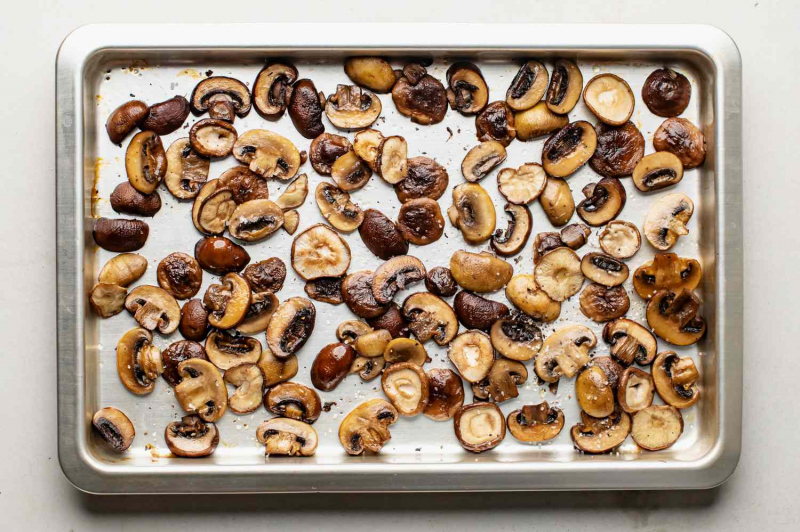They're the Unexpected Star of the Show
What does a great Bolognese—that important combination of mirepoix, tomato, and ground meat served over pasta—really accomplish? Does it take us back in time? Does it carry us home? Bolognese acts as comfort food and as a magic melding of ingredients, it’s one that summons the notes our palates crave most, one that summons memory and fondness long since packed away. Sweet tomatoes. Earthy meat. Carbohydrates. Savory onions, carrots, and celery, all cooked in fat. This dish boasts every last bit of flavor.
But the mood these days—for both environmental and health reasons—propels us toward meals made with less meat. That means finding adequate substitutes that can bring the kind of umami sensibility that meat does. Being meaty does not necessarily have to mean eating meat. Browning—one of the addictive flavor profiles that we associate with meat—can be readily achieved on vegetables, too. In meat, the rearranging of amino acids that turns it brown, crusty, and nearly sweet is called a Maillard reaction. It’s what happens when you introduce high heat to a dry steak. It’s the char and everything that comes with it.

Mushroom Bolognese 65 mins 35 ratings
But vegetables can assume those deeply savory, brown flavors, too, as the natural sugars in them convert and turn dark through a different process: caramelization. It is fair to say that cauliflower, no matter how charred, will likely not convince you to ditch ground meat forever. But an able—even superlative—substitute for meat is the humble mushroom, itself an earthy food prone to browning under the right circumstances. In the quest to eat a little less meat, consider mushrooms not merely a “good enough” substitute of the meat you’re missing. They’re the unexpected star of the show.
A little about meat while we’re at it. The craveable content of actual animal-based protein comes down to chemistry—both the chemistry of what we’re eating and how it moves from raw to cooked and the chemistry of how our brains receive the final product. That Maillard Reaction is part of the draw, since browning triggers pleasure points in the brain based on smell, color, and texture. But we can’t overlook the actual texture of meat itself. Individual preference is, well, individual. Some steak eaters prefer a tender, fat-less filet mignon, while others enjoy the sinewy, muscular sirloin cut. Regardless of personal preference, though, texture matters.
To crave a steak, say, is to crave more than just a steak’s particular flavor. The love of steak betrays a complicated dance of all of the qualities that make steak just exactly what it is. Black bean burgers never became the Next Big Thing because black beans lack some of the components that make meat compelling. Bite into a soft, toothless burger made from beans and suffer the disappointment of meat’s absence.
Mushrooms don’t suffer from the same problem of lack. Richly textured, capable of deep browning, and stocked with ample supply of the so-called sixth taste umami, mushrooms can capably stand in for meat (or, at the very least, can make up the balance if you’re merely looking to reduce the amount of meat used in a recipe) when you need them to most. A black bean burger may not do it for you, but roasted mushrooms chopped and blended into a patty? I’d eat that.

In the case of Bolognese, where the meat itself is both integral and elusive—it isn’t the meat that makes Bolognese great, but, rather, the combination of all of the ingredients at once—mushrooms can carry more than their share of the load. I’ll argue a somewhat unpopular point, from the perspective of meat-eaters and animal protein devotees, at least: mushroom Bolognese is better than the original. It’s a stunning reminder of the diversity of plant-based foods and of the notion that “giving up” meat may not require that much actual sacrifice after all.
Another feather in the mushroom Bolognese cap? Mushrooms can cost less than meat—especially if your meat shopping includes environmental and humane-based mindfulness. A pound of grass-fed organic ground beef can cost anywhere from $7 to $10 per pound. A pound of cremini mushrooms will cost you half that.
Still, you may want to splurge for the good stuff when it comes to mushrooms. Choose a mushroom with good texture, to start. While those ubiquitous, grocery store white button mushrooms make for fine filler, it’s worth investing in some fuller bodied, heartier mushrooms for the bulk of your work. Shiitakes work well, as do creminis. A mix of mushrooms will amplify and deepen the flavor of your final dish. If specialty mushrooms feel like they’re bound to break the bank, opt for mostly white mushrooms with a few wild ones mixed in. As with meat, mushrooms offer permutations. You can choose your own adventure.
In the case of Bolognese, browning is the most essential part. Don’t salt your mushrooms. Allow them to go over to the dark side. Endure the slow wading of time. A Bolognese is a slow dance, regardless of its ingredients. The result—a hearty, warming, synapse-firing dish—will trigger all those old memories and love affairs with meat. It is different than the original. It is—dare I say it?—actually better.